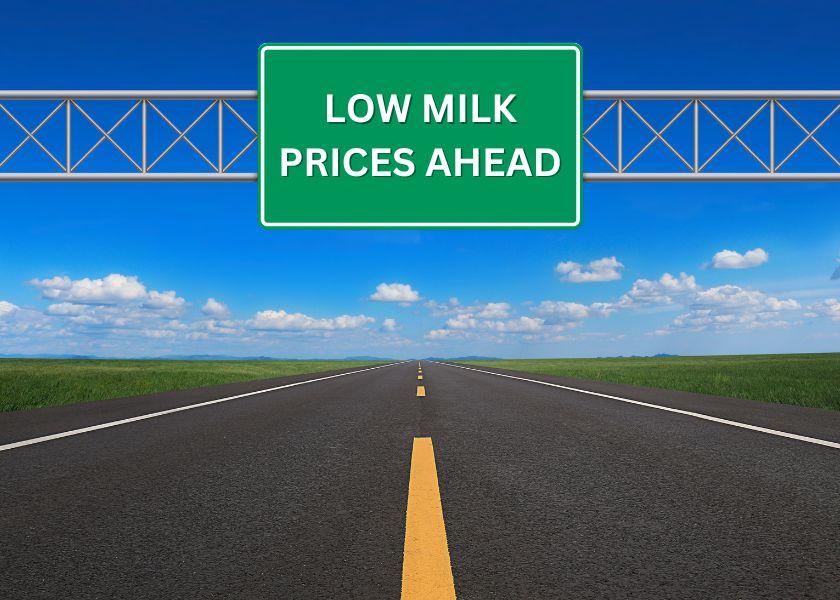Low Milk Prices May Last Longer

Milk futures are as bearish now as they were bullish a year ago. The attitude is completely different. The industry and traders were concerned over milk supply a year ago due to heavy culling. Now, cow numbers are at their highest level since August 2021 at 9.435 million head.
Buyers of dairy products have not been aggressive on the daily spot market as they have been able to purchase product in the country as well as on the spot market without having to aggressively bid for it. Over the past few weeks there has been quite a bit of cheese and dry why that has been traded on the daily spot market even at these lower prices. Sellers have been bringing it to the market to move supply. This indicates supplies are plentiful or manufacturers intend to hold less product in inventory. The most recent cold storage report showed American cheese and total cheese inventories nearly the same a year ago. Other cheese and Swiss cheese inventories were lower than a year ago. That should not be a bearish factor on the market.
This makes one wonder if buyers and sellers are somewhat of the same mind for different reasons. Sellers want to hold less inventory and would rather move supply to the market as quickly as possible. Buyers on the other hand do not want to aggressively purchase and build inventory for later demand at this time of year. However, buyers are willing to purchase at these lower prices as long as sellers are offering it. But even though there has been quite a bit of trading activity on the spot market, overall inventories have not been building. So, demand must be absorbing it. Yet, reports do not indicate there is exceptional demand out in the country. This leaves the market in a certain state of confusion which most often can be bearish to a market.
It will be interesting to see the market unfold over the next few months. Lower milk prices may increase culling and cull cow prices are high and much better than they were 1 1/2 years ago when culling increased significantly. However, many farms used their money last year from good milk prices to pre-pay for some of their needs this year putting them in a fairly good financial position though a period of low milk prices. Culling may increase as the minimum production threshold of a cow might be raised or they may be moved for some other reasons, but it may not be as aggressive as it was in later 2021 which led to record milk prices in spring of 2022.
One aspect that is a huge help is the Dairy Margin Coverage program. There have been significant payouts so far this year with only three months on the books. Large farms use up the large payouts early while smaller farms can have an ongoing supplement to their income due to the low income over feed prices. The most recent income over feed price for the month of March was $6.08 resulting in a payment of $3.42 per cwt if the $9.50 level was chosen under the program. The February income over feed price was $6.19 with a payment of $3.31 per cwt. January recorded an income over feed price of $7.94 and a payment of $1.56 per cwt. The total payout for far under the Dairy Margin Coverage program was $8.29 per cwt for the first three month of the year. This may be a factor in the culling of cows as this supplemented income will keep some farmers in a better financial position than the current market suggests.
Milk prices may remain low for a few months as dairy products continue to remain in good supply and available to the market. The duration of these lower prices will be difficult to predict.
Robin Schmahl is a commodity broker with AgDairy, the dairy division of John Stewart & Associates Inc. (JSA). JSA is a full-service commodity brokerage firm based out of St. Joseph, MO. Robin’s office is located in Elkhart Lake, Wisconsin. Robin may be reached at 877-256-3253 or through the website www.agdairy.com.
The thoughts expressed and the basic data from which they are drawn are believed to be reliable but cannot be guaranteed. Any opinions expressed herein are subject to change without notice. Hypothetical or simulated performance results have certain inherent limitations. Simulated results do not represent actual trading. Simulated trading programs are subject to the benefit of hindsight. No representation is being made that any account will or is likely to achieve profits or losses similar to those shown. There is risk of loss in trading commodity futures and options on futures. It may not be suitable for everyone. This material has been prepared by an employee or agent of JSA and is in the nature of a solicitation. By accepting this communication, you acknowledge and agree that you are not, and will not rely solely on this communication for making trading decisions.







